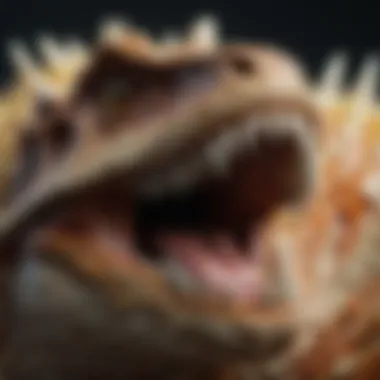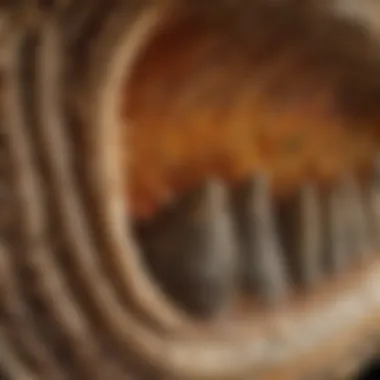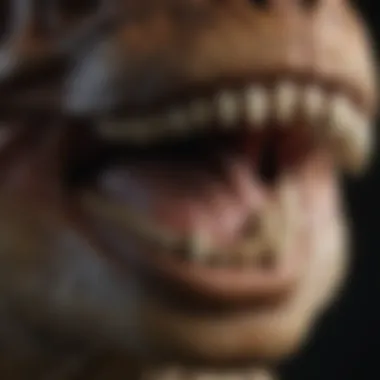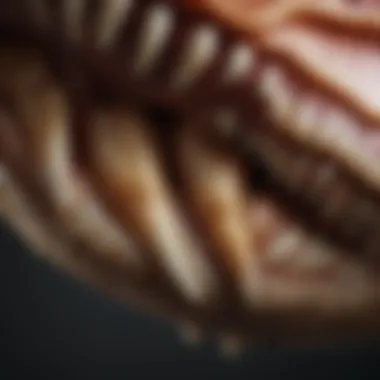Unveiling the Intriguing Attributes of Tyrannosaurus Rex Teeth


Rock and Fossil Identification
Delving deeper into the astonishing world of Tyrannosaurus Rex teeth requires an understanding of the rocks and fossils that house these incredible specimens. Paleontologists must meticulously identify different types of rocks and fossils to unearth the treasures within. When embarking on such a journey, aspiring collectors should look for specific characteristics that indicate the presence of fossilized remains. Utilizing tools like chisels, brushes, and magnifying glasses becomes essential in the precise identification of these ancient remnants.
Understanding the Structure of Tyrannosaurus Rex Teeth
As we unravel the mysteries shrouding these fearsome predators, it becomes apparent that their teeth hold the key to understanding their voracious appetites and hunting prowess. Each tooth is uniquely adapted to fulfill a specific role in the feeding process, from grasping and tearing to crushing bones. Examining the serrated edges, varying sizes, and robust composition of these teeth unveils a complex dental structure honed for survival and dominance in the prehistoric landscape.
The Importance of Tooth Function in Paleontological Research
Unraveling the functional aspect of Tyrannosaurus Rex teeth offers invaluable insight into the behavioral patterns of these colossal carnivores. By analyzing wear patterns, tooth morphology, and dental alignment, researchers can reconstruct the feeding habits and diet preferences of these apex predators. This in-depth investigation sheds light on how these formidable teeth played a pivotal role in the survival and evolutionary success of the Tyrannosaurus Rex species.
Synthesizing Dental Evidence for a Comprehensive Understanding
By synthesizing the wealth of data extracted from Tyrannosaurus Rex teeth, paleontologists assemble a cohesive narrative of these majestic creatures' lives. The integration of dental research provides a holistic perspective on the intricacies of the Tyrannosaurus Rex's ecosystem interaction, social behavior, and adaptations over time. This synthesis bridges the gap between biological evidence and paleontological interpretations, offering a compelling narrative of the ancient predator's existence.
Introduction
In this exploration of the fascinating features of Tyrannosaurus Rex teeth, we embark on a journey to unravel the enigmatic characteristics of these iconic dinosaur predators. The teeth of Tyrannosaurus Rex hold a profound significance in the realm of paleontology, offering a unique window into the evolutionary adaptations and predatory behaviors of this fearsome creature.
The dentition of Tyrannosaurus Rex serves as a compelling subject of study due to its implications for understanding not just the anatomy of the dinosaur itself, but also the broader ecological context in which it thrived. By delving into the intricacies of T-Rex teeth, researchers can glean insights into the hunting strategies, diet, and ecosystem dynamics of this apex predator from the Cretaceous period.
This article delves into the nuanced structure, functional adaptations, and research implications of Tyrannosaurus Rex teeth, shedding light on the multifaceted significance of these dental features. From the evolutionary trajectory that shaped their design to the practical applications in modern science, the exploration of T-Rex teeth promises to unveil compelling revelations about one of the most formidable predators to have roamed the Earth.


Evolutionary Importance of Tyrannosaurus Rex Teeth
In the vast landscape of paleontology, the evolutionary trajectory of Tyrannosaurus Rex teeth stands as a paramount subject of intrigue and study. These remarkable dental structures hold the key to unraveling the essence of survival and dominance in prehistoric ecosystems. Through an in-depth exploration of the Evolutionary Importance of Tyrannosaurus Rex Teeth, one can decipher the intricate adaptations that facilitated the apex predator's reign. The convergence of dental structure adaptations and functional significance sculpted the formidable predator we envision today.
Dental Structure Adaptations
Shape and Size Variations: The Shape and Size Variations observed in Tyrannosaurus Rex teeth are not merely random features but intricately crafted elements designed for efficiency in hunting and feeding. The serrated edges and robust build of these teeth denote a specialization in tearing through flesh and crushing bone, showcasing the predator's prowess in subduing prey. The strategic arrangement of shapes and sizes optimizes the efficiency of each tooth, enabling the dinosaur to maintain its predatory edge in a competitive ecosystem.
Tooth Replacement Patterns: Delving into the Tooth Replacement Patterns uncovers a saga of relentless regeneration that fueled the hunting capabilities of Tyrannosaurus Rex. The cyclical mechanism of tooth replacement ensured that any wear and tear from ferocious encounters were swiftly remedied, maintaining a pristine set of weapons for predatory pursuits. This unique adaptation exemplifies nature's innovation at its finest, offering the predator a perpetual arsenal to dominate its ecological realm.
Functional Significance
Bite Force Analysis: The Bite Force Analysis delves into the mechanics behind the crushing power of Tyrannosaurus Rex jaws, unveiling a force capable of shattering bones with unparalleled precision. The robust structure of the skull coupled with muscular prowess accentuates the formidable bite force, underscoring the predator's efficient prey immobilization strategy. This functional aspect not only highlights the raw strength of the dinosaur but also underscores its specialized adaptations for efficient feeding.
Prey Handling Mechanisms: Examining the Prey Handling Mechanisms reveals a sophisticated interplay of tooth morphology and jaw movement tailored for securing and consuming prey. The intricate interlocking of teeth during feeding not only enhances gripping capacity but also aids in dismembering large carcasses for consumption. This functional synergy between dental structure and feeding behavior illuminates the strategic nuances of Tyrannosaurus Rex's hunting methodology, showcasing a blend of power and precision in its predatory pursuits.
Physical Characteristics of Tyrannosaurus Rex Teeth
Tyrannosaurus Rex teeth hold a pivotal role in the field of paleontology, reflecting a fascinating array of physical characteristics that contribute significantly to our understanding of this iconic predator's biology. Their structure and composition offer unique insights into the evolutionary adaptations and functional capabilities of these formidable teeth. Exploring the physical characteristics of Tyrannosaurus Rex teeth unveils crucial information essential for deciphering the hunting and feeding behaviors of this apex predator.
Enamel Composition
The enamel composition of Tyrannosaurus Rex teeth is a critical aspect that showcases exceptional hardness and wear resistance. This robust enamel plays a vital role in protecting the teeth during feeding and hunting activities. Its durability and strength enable the teeth to withstand the forces exerted while consuming prey, highlighting the predatory prowess of this ancient carnivore.


Hardness and Wear Resistance
The specific attribute of hardness and wear resistance in Tyrannosaurus Rex enamel enhances its longevity and functionality. This feature ensures that the teeth remain resilient against the rigorous demands of tearing through flesh and bone, showcasing unparalleled durability in the prehistoric environment. The remarkable hardness of the enamel contributes to the efficient hunting and feeding capabilities of Tyrannosaurus Rex, exemplifying its adaptation for predatory success.
Dentine Structure
The dentine structure of Tyrannosaurus Rex teeth plays a significant role in providing shock absorption properties that aid in maintaining tooth integrity under duress. This structural component complements the enamel's protective function, safeguarding the teeth from damage during volatile feeding actions. The dentine structure possesses intrinsic qualities that contribute to the overall resilience and effectiveness of the teeth, offering insights into the mechanical adaptations of this apex predator.
Shock Absorption Properties
The shock absorption properties of dentine in Tyrannosaurus Rex teeth help mitigate the impact of forceful interactions during feeding, contributing to the longevity and stability of the teeth. This feature offers a crucial cushioning effect, reducing the risk of fractures or breakages, thus ensuring the sustained functionality of the teeth for efficient prey consumption. The unique shock absorption properties of dentine showcase the evolutionary advantages conferred upon Tyrannosaurus Rex in its predatory pursuits.
Root Configuration
The root configuration of Tyrannosaurus Rex teeth serves the essential functions of anchoring and providing structural support to the formidable dental apparatus. This specialized configuration offers stability and reinforcement to the teeth, ensuring their secure positioning within the jaw for effective biting and tearing actions. The root structure of Tyrannosaurus Rex teeth enhances the overall functionality and longevity of these critical dental tools, underscoring their significance in the predator's feeding ecology.
Anchoring and Support Functions
The anchoring and support functions of the root configuration in Tyrannosaurus Rex teeth are instrumental in maintaining tooth stability and endurance during feeding activities. This feature enhances the gripping power of the teeth, enabling efficient prey handling and consumption. The unique design of the root structure optimizes tooth functionality, contributing to the predatory success of Tyrannosaurus Rex in its ancient ecosystem. This section provides a detailed examination of the specialized adaptations present in the physical characteristics of Tyrannosaurus Rex teeth, shedding light on their remarkable attributes and evolutionary significance.
Research Insights on Tyrannosaurus Rex Teeth
In the realm of paleontological exploration, delving into the research insights on Tyrannosaurus Rex teeth unveils a treasure trove of knowledge essential for understanding these ancient predators. Through meticulous analysis and interpretation, researchers can glean valuable information regarding the feeding habits, hunting techniques, and ecological adaptations of the mighty Tyrannosaurus Rex.


Microscopic Analysis stands as a pivotal aspect of unravelling the mysteries surrounding Tyrannosaurus Rex teeth. Within the domain of Microscopic Analysis, Stress Distribution Studies play a crucial role in elucidating how forces are distributed across the tooth structure during biting and feeding actions. By examining stress patterns, researchers can discern the resilience and effectiveness of T-Rex teeth in handling powerful bites and rending flesh. The unique characteristic of Stress Distribution Studies lies in their ability to provide insights into the mechanical properties of T-Rex teeth, shedding light on their structural integrity and functional prowess within the predator's hunting arsenal.
Moreover, Microstructure Investigations amplify our understanding of Tyrannosaurus Rex teeth by exploring the intricate details of their composition at a microscopic level. By scrutinizing the microstructure, researchers uncover the fine-scale features that contribute to the overall strength and durability of T-Rex teeth. This method offers a granular view of the tooth's material properties, elucidating how the arrangement of dentine, enamel, and other components influences its performance during feeding behaviors. Although time-consuming, Microstructure Investigations stand out as a valuable tool for deciphering the evolutionary adaptations and mechanical advantages embedded within the teeth of Tyrannosaurus Rex.
On the other hand, Isotopic Studies provide a distinct perspective on the dietary preferences and behaviors of Tyrannosaurus Rex, offering valuable insights into the ecosystem dynamics of the Cretaceous period. Within Isotopic Studies, Dietary Inferences serve as a linchpin for deciphering the food choices and trophic interactions of these apex predators. By analyzing isotopic signatures preserved in T-Rex teeth, researchers can discern the types of prey consumed, the trophic levels occupied, and the dietary preferences exhibited by these formidable carnivores. The unique feature of Dietary Inferences lies in their ability to reconstruct ancient food webs and ecological relationships, providing a glimpse into the paleoecological landscape inhabited by Tyrannosaurus Rex.
In essence, the research insights derived from microscopic analyses and isotopic studies on Tyrannosaurus Rex teeth not only enrich our understanding of these iconic predators but also contribute significantly to the broader field of paleontological research, offering a glimpse into the intricate adaptations and behavioral patterns of one of the most fearsome creatures to have roamed the Earth.
Practical Applications of Studying Tyrannosaurus Rex Teeth
The importance of delving into practical applications of Tyrannosaurus Rex teeth is twofold. Firstly, through paleoecological reconstructions, researchers can gain profound insights into the ecological niches occupied by these apex predators millions of years ago. By understanding their dietary preferences and interactions with other species, scientists can paint a vivid picture of ancient ecosystems and how T-Rex shaped them. This knowledge enables a deeper comprehension of prehistoric biodiversity and environmental dynamics.
Secondly, the study of T-Rex teeth can inspire advancements in bioengineering by uncovering material science innovations. By analyzing the unique features of these teeth, such as enamel composition and dentine structure, researchers can derive new insights into designing materials with similar properties. This interdisciplinary approach between paleontology and bioengineering opens up avenues for creating cutting-edge technologies and biomimetic materials that emulate the durability and functionality of T-Rex teeth in modern applications.
Overall, the practical applications of studying Tyrannosaurus Rex teeth extend far beyond mere speculation about extinct creatures. They offer tangible benefits to fields as diverse as paleoecology and bioengineering, enriching our understanding of the past while driving innovation for the future of science and technology.
Conclusion
In the grand scheme of this detailed exploration into the fascinating features of Tyrannosaurus Rex teeth, the conclusion serves as a pivotal reflection point that encapsulates the essence of our findings. Throughout this scholarly journey, we have meticulously dissected the evolutionary importance, physical characteristics, research insights, and practical applications of these iconic teeth, unraveling a tapestry of knowledge that offers a profound glimpse into the world of paleontology. $
Now, as we draw the curtain on this enlightening discourse, it becomes apparent that the implications of delving into the intricacies of Tyrannosaurus Rex teeth extend far beyond mere academic curiosity. The conclusion segment not only synthesizes the wealth of information we have uncovered but also prompts us to ponder the deeper significance of such meticulous scientific investigations into prehistoric creatures.
One of the foremost elements that emerge from this comprehensive study is the critical role that Tyrannosaurus Rex teeth play in deciphering the ancient predator's hunting and feeding behaviors. By examining the dental structure adaptations, functional significance, and microscopic details of these formidable teeth, we are not merely scratching the surface of fossilized remains; rather, we are peering into the very essence of a creature that once ruled the primordial world.
Moreover, the benefits of such a holistic analysis ripple into the realms of paleoecological reconstructions and bioengineering inspirations. Through our scholarly pursuit, we gain insights into the ecological niche assessments, population dynamics, material science innovations, and dietary inferences that stem from a thorough understanding of Tyrannosaurus Rex teeth. These practical applications underscore the real-world implications of studying ancient dentition beyond the confines of laboratories and academic journals.
As we reflect on the meticulous details presented throughout this article, we are propelled to consider not just the teeth themselves but the profound stories they unveil about the survival strategies, evolutionary adaptations, and intricate dynamics of an apex predator from a bygone era. The conclusion, therefore, serves as a bridge that connects the minutiae of scientific inquiry with the broader narrative of Earth's history, inviting us to marvel at the complexities of life and evolution.
In essence, the conclusion segment of this article stands as a testament to the ceaseless pursuit of knowledge, the unending quest to unravel the mysteries of the past, and the unwavering dedication of scientists and enthusiasts to preserve the legacy of creatures long extinct. Through a lens sharpened by curiosity and guided by intellect, we not only explore the fascinating features of Tyrannosaurus Rex teeth but also embark on a journey of discovery that transcends time and ignites the flames of scientific inquiry for generations to come.







